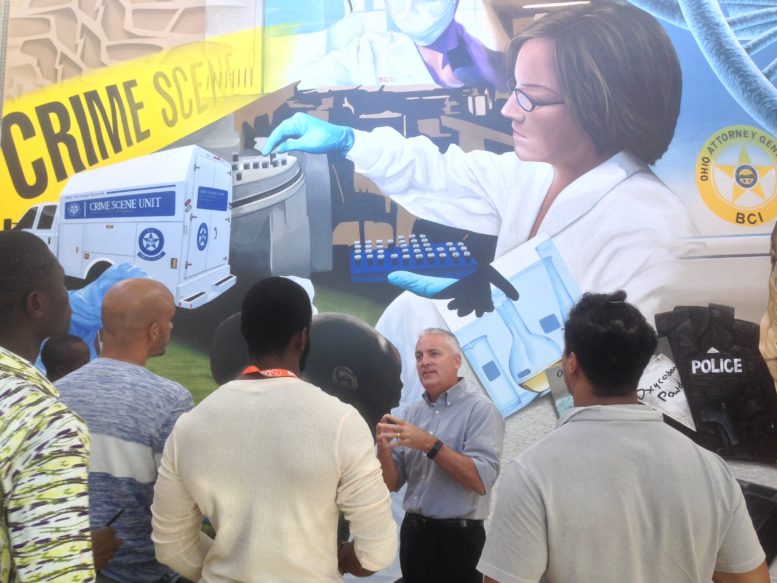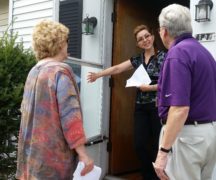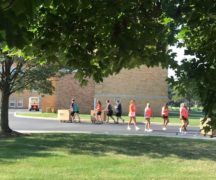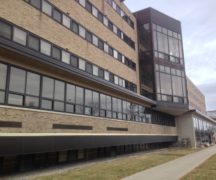By DAVID DUPONT
BG Independent News
University and local officials used the Ohio Town and Gown Summit on the Bowling Green State University campus last week to shine a light on their efforts to ink the campus and surrounding community.
Thursday’s after-lunch keynote address offered a one-two punch of Mayor Richard Edwards and Bowling Green State University President Rodney Rogers. Both also tipped their hats to someone who could not be there, President Emeritus Mary Ellen Mazey. Though scheduled to return to campus for the summit, Mazey was not able to attend because of illness, Edwards said.
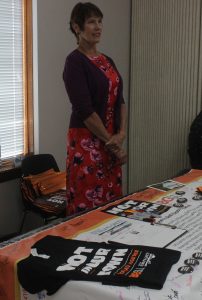
Emily Dunipace at the Not In Our Town table during Thursdays Best Hometown Celebration. NIOT was a collaboration of BGSU and the city f Bowling Green to address incidents of intolerance and hate on campus and in the city.
Edwards knows about the relationship between communities and universities, having forged a career in both settings, including as a vice president at BGSU and Wood County Administrator, before assuming his current duties.
He credited Mazey with being a driving force behind the increased cooperation between the city and campus.
Not long after they’d met she told him: “Dick, let’s do a joint vision study.”
That rang a “’yes’ bell in my head,” Edwards said.
Kent, the home of Kent State University, serves as a model for what BG and BGSU hope to achieve. It now has a major thoroughfare effectively linking the two entities. That did not come easily. Edwards recalled fierce local opposition to an earlier attempt to do that.
He quipped that he’d forgotten to ask his fellow mayors in attendance what brand of flak jacket they wore.
Bowling Green’s version is a new vision for the East Wooster corridor stretching west from I-75 interchange into downtown. The project on the east end is ready to begin the construction phase.
Rogers said that public universities have a special responsibility to serve the public good. That includes giving students the means to be socially mobile.
That responsibility extends to doing “relevant and meaningful research” on issues of societal concern, he said. Those include the opioid crisis and water quality. Beyond that university must find ways to link that research to inform public debate on those issues.
The university must also find public-private partnerships that help make sure “the cost of education does not get out of reach,” Rogers said. Private enterprises can provide some services more efficiently, and that “has allowed us to make savings that we were able to reinvest in programs.”
A panel that immediately followed the keynote presentation addressed specific collaborations in those areas.
Kim Murnieks, the chief operations officer in the state attorney general’s office, talked about how the Bureau of Criminal Investigation laboratory was built on campus.
The state had an aging, inadequate lab in Bowling Green, and it was also facing a shortage of people trained in forensic science.
The project allowed a state of the art lab to be built on university property. The presence of the lab has sparked a growth in forensic science on campus, including the creation of a master’s degree.
This provides not only a rising cohort of forensic scientists but also continuing education opportunities for professionals already in the field. Students have the chance to do internships in the lab.
Also, she said, BGSU’s Center for the Future of Forensic Science is engaged in cutting edge research to further the field.
Stan Korducki, president of the Wood County Hospital, discussed the building of the Falcon Health Center.
He said that while the former university-operated facility was staffed with excellent and caring personnel the actual facilities were outdated. He felt that the Wood County Hospital could do a better job.
He discussed this with BGSU President Sidney Ribeau and seemed to be making progress, then Ribeau left to become president at Howard University. During President Carol Cartwright’s two-year tenure, other issues took precedence. When he met with Mazey, he brought up the possibility. She was receptive. She told him that’s what they did at Auburn, where she had been provost and vice president.
Rogers in his remarks earlier said that the university then sent out requests for proposals, and the local hospital’s was the winning one.
The Falcon Health Center, located on the southwest corner of East Wooster and South College, and serves not only students but the community, Korducki said.
Nancy Orel, the director of research at the Optimal Aging Institute, said the institute works closely with the Wood County Committee on Aging. The university served as the conduit for the $1.6 million in state funding for the new senior center in Bowling Green. The university helped to show that the current center poses accessibility issues for some of the people it’s intended to serve.
Students, Orel said, do internships with the committee and conduct research.
The center has launched an initiative to look at and address the opioid crisis’ impact on older people. She said 42 percent of people who die from opioid overdoses are over 45. She noted that at a recent conference, Jon Sprague, the director of the Center for the Future of Forensic Science, was one of the speakers.
Wendy Chambers, director of the local Convention and Visitors Bureau, discussed the joint operation of the visitor information center on the periphery of campus.
The center was originally operated by BGSU Parking Services. When that office decided to no longer manage it, the university struck up a partnership with the CVB.
The local group provides a supervisor, and the rest of the staffing is done by students studying tourism, leisure and event planning.
Using students, the CVB is able to staff the center enough hours to merit having a sign on I-75 directing travelers to the center.

